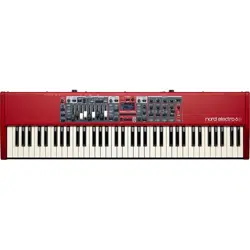Loading ...
Loading ...
Loading ...

22 | NORD ELECTRO 6 USER MANUAL OS V2.6X
EFFECT 2
EFFECT 2 provides a selection of modulation effects,
including two types of Phaser, a Flanger, two Cho-
rus types and a Vibe effect. Each effect has its rate
controlled by the Effect 2 knob.
PHASER 1 & 2
The PHASER effect produces a characteristic
“sweep” effect, commonly used with electric piano
sounds. The digital models for the phasers of the
Nord Electro 6 are inspired by classic units such as
the Bi Phase and the Small Stone.
FLANGER
The FLANGER produces a dramatic comb filter
effect, giving the sound a “swooshy” and resonant quality.
CHORUS 1 & 2
The versatile CHORUS effect gives the impression of “widening”, or with
more extreme settings severely detuning, the sound – achieved by
blending a number of modulated copies of the audio signal. There are
two Chorus types, the second being more bold in character.
VIBE
The VIBE effect draws its inspiration from a classic foot pedal effect and
produces a sound with both pitch-bending and phasing qualities. The
effect is created through a digital model of a staggered series of phasing
filters, unlike the usually aligned filters of a normal phasing effect.
DEEP
Engaging DEEP mode (Shift + Effect 2 selector) increases the modulation
amount for any Effect 2 selection.
DEL AY
The DELAY unit produces echo/repeat effects. The
Delay time is set by tapping the TEMPO button, or
by pressing down on it and SET the tempo using
the Program section dial.
The FEEDBACK button determines the number of
delay repeats, or taps. At the lowest setting (LED
unlit) only the initial tap is heard, while the 1, 2 and 3
settings give an increasingly long feedback tail.
The DRY/WET knob adjusts the balance between
the dry signal and the delay repeats.
PING PONG
Press PING PONG (Shift + Tempo) to activate Ping
Pong mode. This causes delay repeats to alternate
between the left and right channels. If short delay times are used, these
repeats will be “asymmetrical” and produce delays that are more like
early reflections in reverb units.
TEMPO TAP
Use TAP to set a delay time matching the tempo of a song. Simply tap
the Tempo button in the tempo you wish the delay to sync to a number
of times, and the delay time will be adjusted automatically.
SPKR/COMP
The SPKR/COMP unit combines sophisticated ampli-
fier and speaker cabinet simulations – including the
Rotary Speaker – with a useful compressor effect.
DRIVE/COMP
When no Amp Model or Comp is selected the DRIVE
knob provides a tube style overdrive effect or, if an
amp is selected, controls the amount of overdrive
for that Amp model. If the Drive LED is lit, it indicates
that overdrive is active.
AMP MODEL
The three different amplifier/speaker simulations –
four if counting the Rotary – are selected with the
Selector button in the Amp Model section:
Amp Model Description
JC
A simulation of a classic solid-state amplifier
and speaker cabinet.
SMALL
A simulation of the built-in tube amp and
speakers of a reed-based electric piano.
TWIN
A simulation of a classic twin speaker tube
amplifier and cabinet.
ROTARY
The ROTARY effect accurately reproduces the sound of the rotating horn
and bass rotor, as well as the characteristics of the built-in amplifier of
the original rotary construction.
• As a nice shortcut, the Rotary effect is automatically activated when
the Rotary speed control (SLOW/STOP, FAST) to the left of the Organ
section is operated – if the Spkr/Comp unit is turned off. The source
for the Rotary effect will be set to the leftmost of the active sound
engines.
• Switch between fast and slow rotor speeds by pressing the SLOW/
STOP, FAST button.
• To stop the rotors, press the STOP MODE button and set the speed
to SLOW/STOP (this does not deactivate the Rotary Speaker – it only
stops the rotors). When the Slow/Stop button is pressed again the ro-
tors will accelerate to the Fast speed setting. This functionality mimics
the behavior of an early, one speed rotary speaker.
• The rotor acceleration rate, the time it takes to go from slow to fast
and vice versa, can be adjusted on the Sound menu, read more on
page 28. The DRIVE knob in the Spkr/Comp section controls the
amount of overdrive. This simulates the pre-amplifier overdrive of the
original rotary speakers.
A sustain pedal or a foot switch that is connected to the Rotor pedal
input can control the rotor speed. On the Nord Electro 6 D models, the
optional Nord Half Moon Switch can be used for switching Rotary speed
in an even more traditional fashion.
Loading ...
Loading ...
Loading ...
